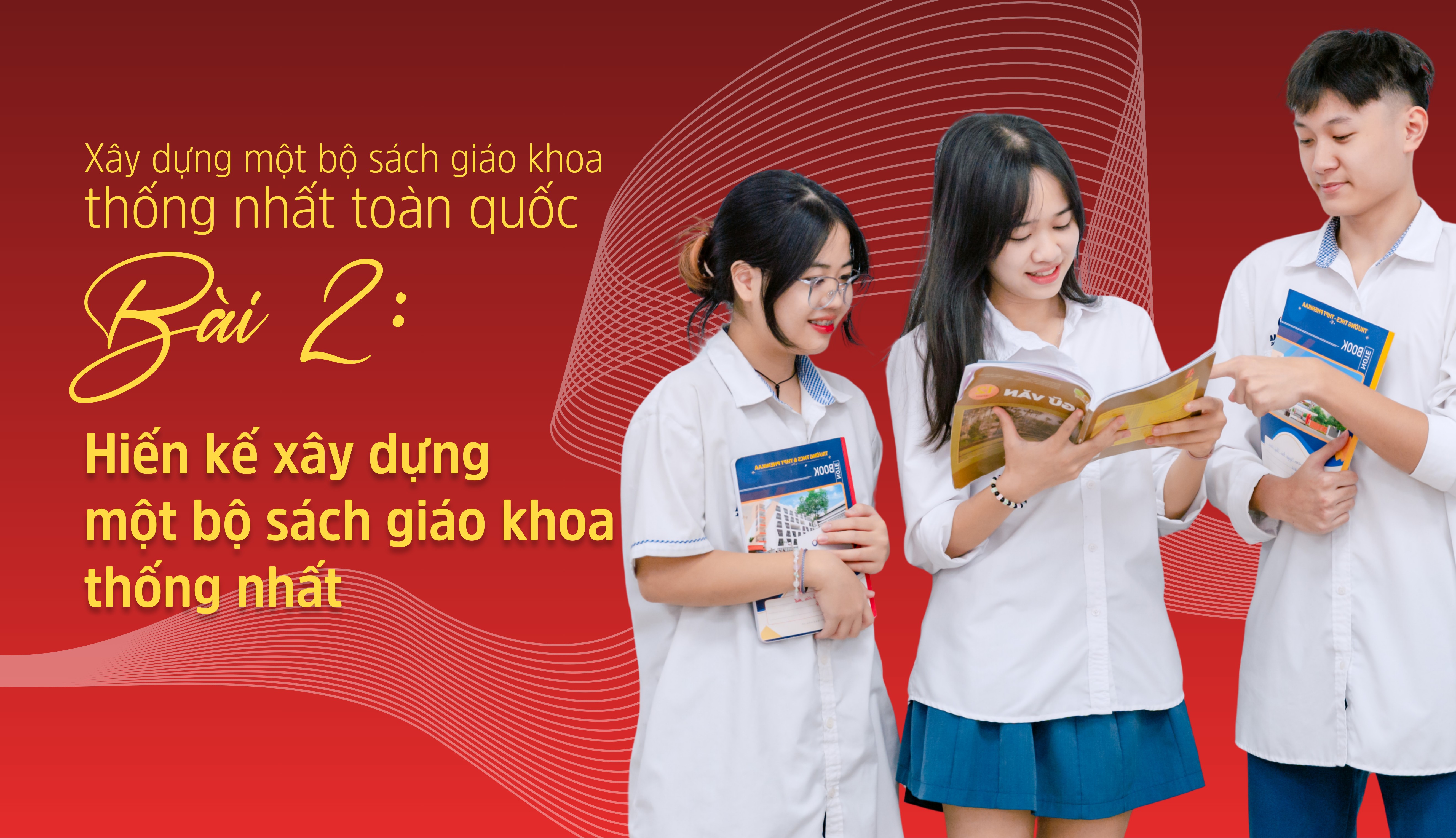
GD&TĐ - In the Action Program to implement Resolution 71-NQ/TW, the Government identified the key task: "Ensuring the provision of a unified set of textbooks nationwide from the 2026-2027 school year". Managers and experts offered advice to realize this important directive.
Associate Professor, Dr. Le Huy Hoang - Deputy Head of the Department of Education , Central Propaganda and Mass Mobilization Commission: 6 important requirements when compiling a unified set of textbooks.
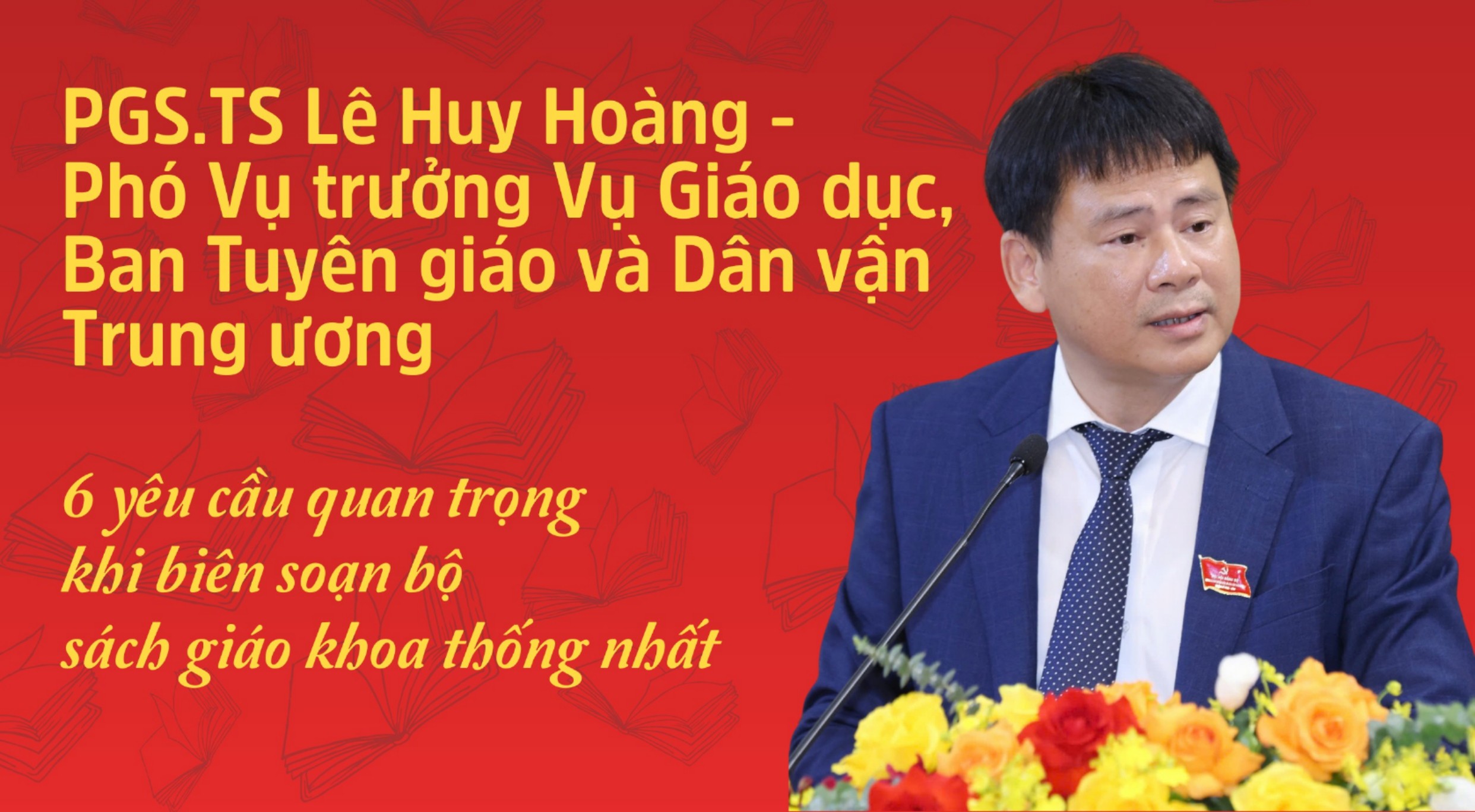
On August 22, 2025, the Politburo issued Resolution No. 71-NQ/TW on breakthroughs in education and training development (Resolution 71). This is a Resolution of strategic significance, demonstrating the Party's determination to make education a key driving force for national development in the new period. In the overall direction of breakthrough innovation, the Resolution requires ensuring the provision of a unified set of textbooks nationwide, striving to provide free textbooks to all students by 2030.
In the Government's Action Program to implement Resolution 71 (issued under Resolution No. 281/NQ-CP, dated September 15, 2025), the Government agreed to "ensure the provision of a unified set of textbooks nationwide for use from the 2026-2027 school year".
Thus, there is less than a year left for the Ministry of Education and Training and related units to direct the development of a unified set of textbooks. This is an extremely difficult and complicated task that requires determination, creativity, cooperation, consensus, and strong promotion of resources and intelligence of society.
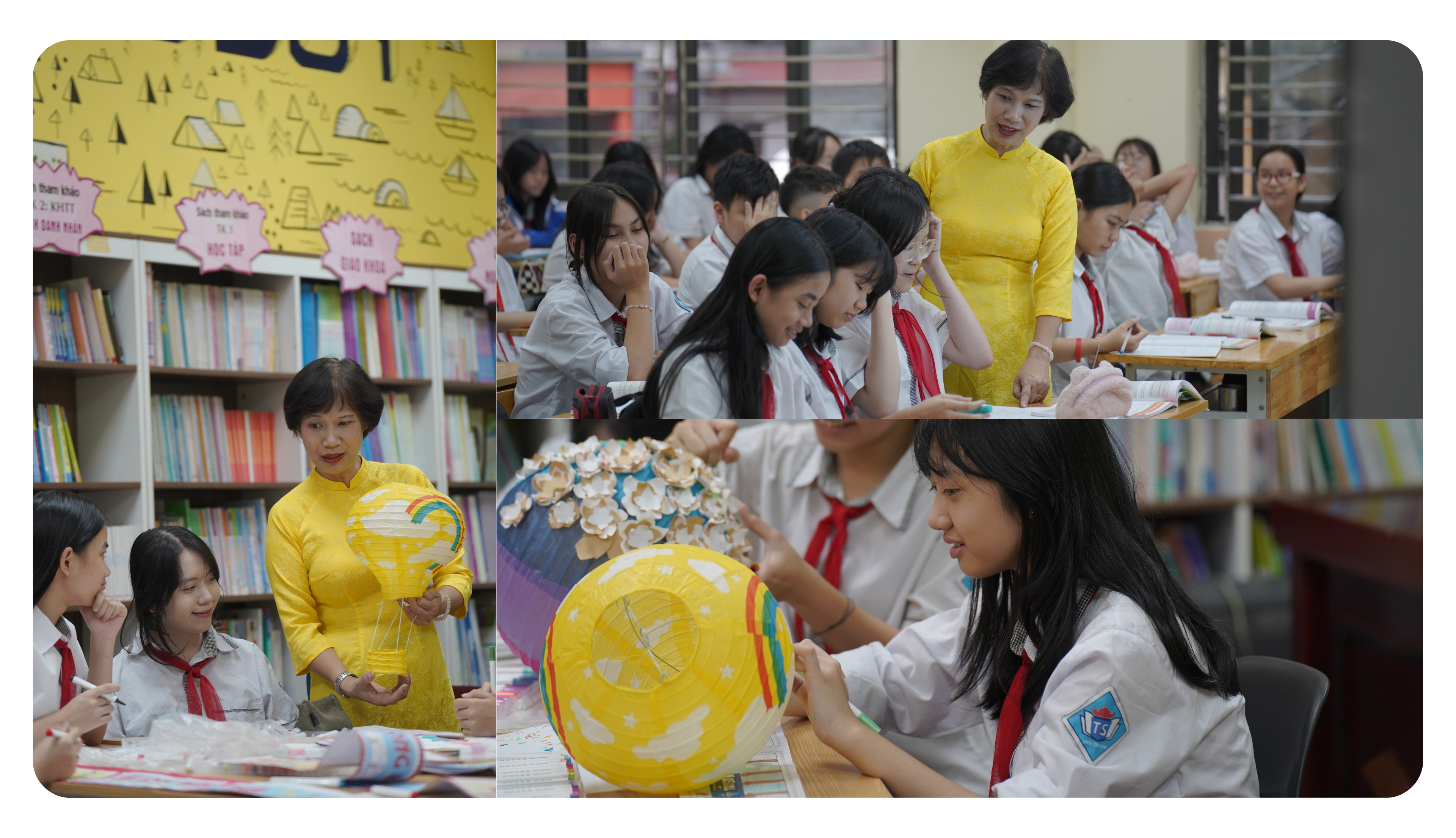
Faced with the need to have a unified set of textbooks nationwide in a short time, many options have been proposed, analyzed and selected. Below are three popular options, mentioned by many scholars and scientists in the past few days.
Option 1: Compile a completely new set of textbooks, separate from the current sets. The advantage of this method is to create uniformity and consistency from the beginning, and have the opportunity to most fully reflect the innovation directions stated in Resolution 71. However, given the complexity and huge workload, compiling a new set of textbooks within a year is not feasible, posing potential risks to quality.
Option 2: Choose one of the three current textbooks as a basis, then upgrade and modify it into a unified textbook set. This option has the advantage of fully inheriting the philosophy and structure of a set of books, saving time and costs. However, the limitation is that not all subjects in the selected set of books are of good quality, which risks affecting the overall quality of the set of books.
Option 3: Select the best books in each subject from the current textbooks to form a new set of textbooks. You can choose freely by subject, for each grade or add constraints by level, by set to ensure the relative uniformity of the new set of textbooks. This method ensures the quality of each subject, but there is a risk of inconsistency in philosophy, pedagogical style and continuity between levels. For a unified set of textbooks nationwide, this can be considered a significant limitation.
Regardless of the chosen option, the compilation process must ensure objectivity, transparency and scientificity, especially when inheriting current textbooks; the quality and consistency of the book series must be the number one priority, placed above all, first and foremost; the innovation policy of Resolution 71 must be fully reflected in the ideology, structure, content, pedagogical methods and learning materials in the entire book series.
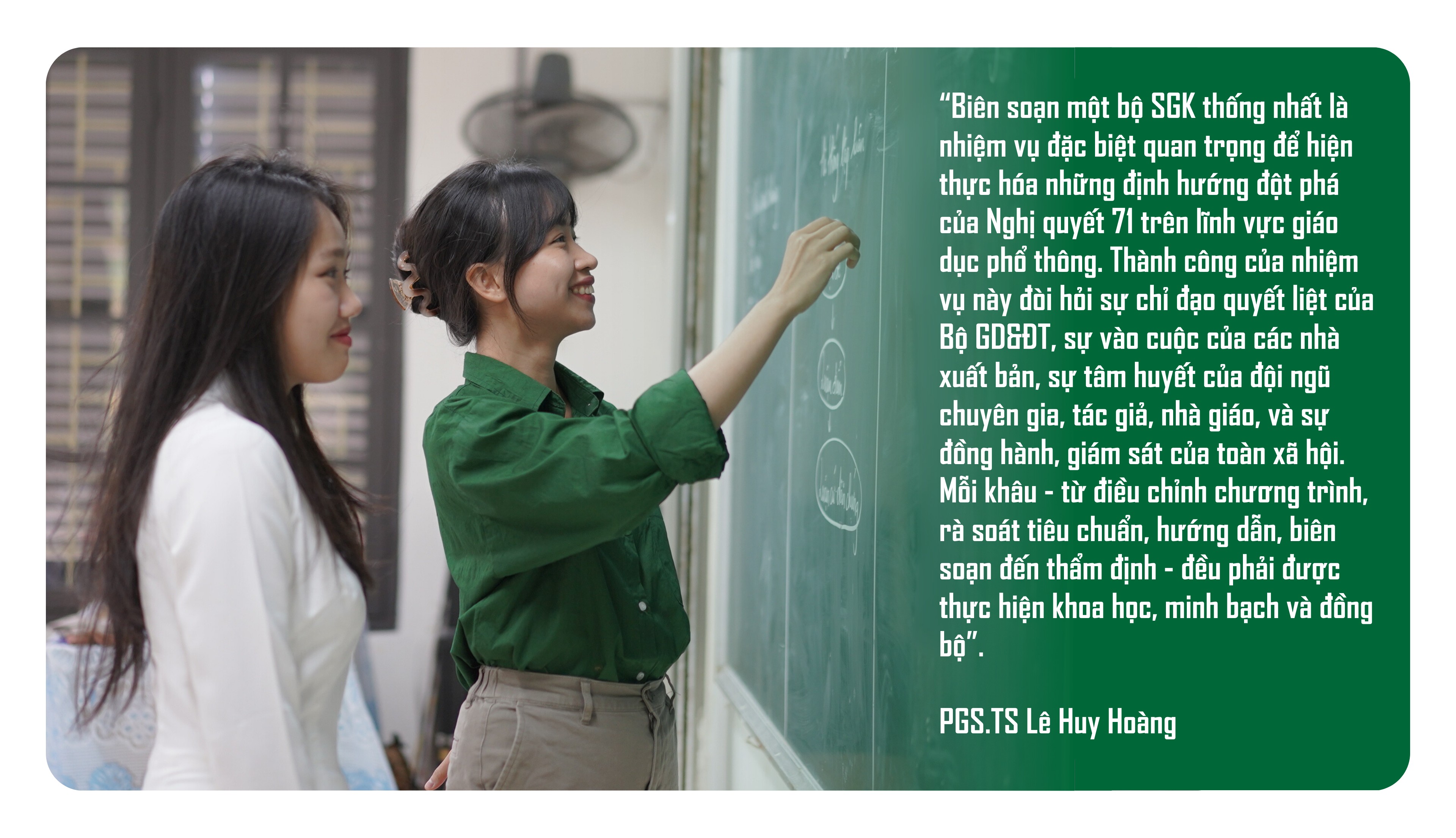
To have a unified set of textbooks that meet the expected quality, it is important to clearly define the principled requirements that govern the entire process of compiling the new set of textbooks. These are not only technical criteria, but also closely linked orientations between the educational development breakthroughs stated in Resolution 71 and each stage and step of the compilation process.
Firstly, the compilation of new textbooks must be based on the updated and completed general education program. This is a prerequisite principle, because textbooks can only be standardized and modernized if they originate from a scientifically adjusted and synchronous program. Updating and completing the program must be based on the following aspects:
Firstly, the results of practical evaluation after 7 years of implementation, thereby identifying advantages, limitations and shortcomings in content, structure, methods, etc.
Second, the new viewpoints, goals, tasks and solutions of Resolution 71 on general education, especially the requirements for comprehensive education in ethics - intelligence - physical fitness - aesthetics, digital capacity, artificial intelligence, STEM/STEAM, foreign languages and the system of values of Vietnamese people in the new era,...
Second, the new set of textbooks must ensure uniformity and standardization nationwide. This is a direct requirement from Resolution 71, overcoming social feedback on the current fragmentation and differences between many sets of textbooks. The uniformity does not only stop at knowledge content but also includes pedagogical ideology, structure, language, terminology, symbols, illustration system and output standards on student capacity and qualities. This requirement requires early adjustment and completion of the set of criteria and regulations on textbooks and the work of compiling and appraising general textbooks.
Third, the compilation of new textbooks must ensure selective inheritance. This is an important principle, because the three current textbooks all meet quality requirements, are approved by the Ministry of Education and Training, and are eligible for use in schools. Inheritance also ensures the promotion of the intelligence and experience of the team of authors, Editors-in-Chief, and Editors of each set of books in upgrading and revising them into new textbooks. Compiling a unified set of textbooks requires knowing how to exploit strengths, good approaches, and good content, while boldly eliminating or editing limitations and shortcomings.
Fourth, the new set of textbooks must be modern and updated. Resolution 71 has clearly stated the need to include knowledge about digital capacity, artificial intelligence, STEM/STEAM education as well as increase the time for science, technology, and information technology subjects in the general education program. This requires that the unified set of textbooks must be linked to the requirements of developing technological capacity, creative thinking, problem-solving ability, and international integration. At the same time, the new set of textbooks must be the foundation for developing smart textbooks for smart education.
Fifth, ensuring comprehensiveness and balance. General education, in the spirit of Resolution 71, must develop harmoniously morality, intelligence, physical fitness, and aesthetics, meaning that the new textbooks cannot only focus on academic knowledge. The content of the books must evoke humanistic values, ethics, and social responsibility, while creating conditions for the development of life skills, health, art, and physical fitness. The new textbooks need to be designed to provide space for experiential activities, practical situations, and exercises related to life, to implement the viewpoints of "learning goes hand in hand with practice", "theory goes hand in hand with practice", and "school goes hand in hand with society".
Sixth, the unified set of textbooks must ensure feasibility and effective implementation. This is a practical requirement. Progress must be fast but not at the expense of quality. The entire compilation process must be organized scientifically, concise but tight, applying digital technology and artificial intelligence to increase productivity, while being transparent and closely monitored. The compilation must also take into account the actual conditions of schools, teachers and students, ensuring that textbooks are close to reality.
Assoc. Prof. Dr. Bui Manh Hung - Chief Coordinator, General Education Program Development Board 2018: 3 options to have a unified set of textbooks.
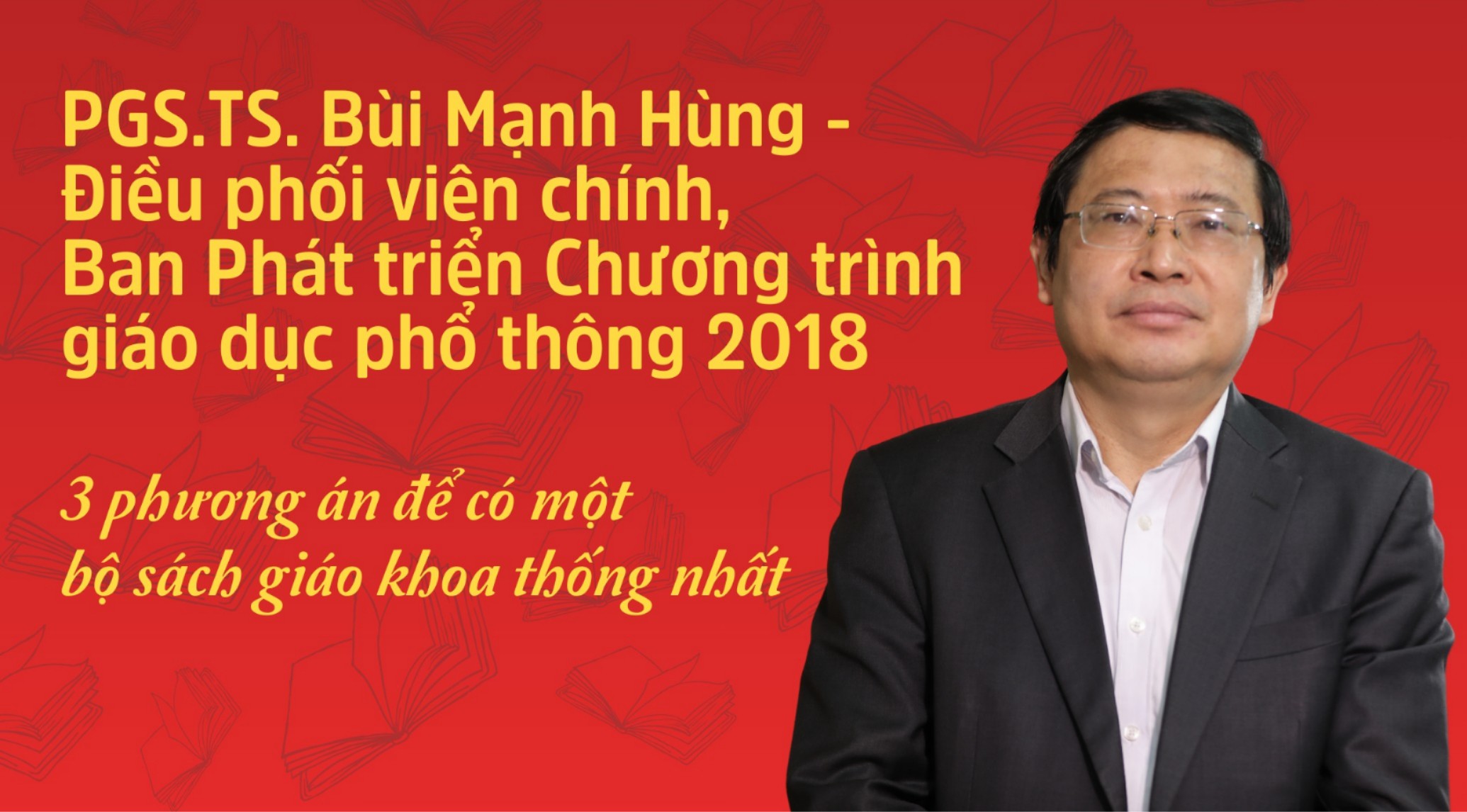
To have a unified set of textbooks, there can be at least 3 options: Organize the compilation of a completely new set of textbooks; choose one of the three existing textbook sets as a common set of textbooks; choose a number of textbooks from each set of books to combine into a common set of textbooks. Each option has its own advantages and limitations. Depending on the requirements for innovation and priority issues, choose the appropriate option.
Option 1: Organize the compilation of a completely new set of textbooks. This option should be considered first if there is enough time and a strong enough team of authors can be mobilized.
In terms of time, it takes about 4-5 years to compile a new set of textbooks for 12 grades. The current textbooks take 6 years to compile (from 2018 to 2023, not including the preparation time of 1-2 years before that, short or long depending on each set of books, plus a few months of training in early 2024). In addition to compilation (including editing, illustration, especially primary school books need a lot of illustrations), there must also be time for trial teaching, appraisal (internal appraisal of the publisher and national appraisal), asking for comments from teachers, experts and teacher training.
Regarding the authors, in our current team of teachers and scientists, there are quite a few talented people who have not participated in compiling textbooks. However, the number of people who meet the requirements for a textbook author is not much. Writing textbooks requires not only a deep understanding of related scientific fields, but also experience, pedagogical skills, understanding of domestic and international programs and textbooks, good presentation skills, the ability to work in groups and dialogue, etc. Not to mention the spirit of dedication to a difficult and stormy job for many years. Therefore, mobilizing authors to compile a new set of textbooks with enough subjects for 12 grades is a big challenge.
When compiling the three current textbooks, we mobilized almost all our forces for a major educational innovation, not thinking that we would have to compile another set of textbooks immediately. It is possible to solve the problem of authorship by mobilizing some people who participated in compiling the three current textbooks. However, this can lead to conflicts of interest because when they are authors of the current textbooks and participate in writing the new textbooks, they will, more or less, use the creative efforts of the old group of authors to contribute to the new group of authors. This is likely to cause many controversies and consequences in terms of intellectual property.
Inheriting information and ideas from current textbooks, along with the support of AI in some stages, the compilation of new textbooks can be shortened compared to before. That is a great advantage. However, inheriting existing textbooks does not mean copying some lessons from each set of books to create a new set of textbooks, because such copying violates copyright issues and does not ensure the necessary system and consistency of a set of books. The new set of textbooks must be upgraded and creative, requiring the author to spend a lot of time and effort, not simply assembling as many people think.
Option 1 has the advantage of having a completely new set of textbooks and opens up the hope of having a set of textbooks called "standard" as many people wish. However, as mentioned above, it requires time to implement and a team of authors to implement, the entire education sector must make an effort once again after a long race against time. Because it was compiled later, in the context of implementing Resolution 71, the newly compiled set of textbooks must definitely have higher quality than the current sets of textbooks. Otherwise, it is difficult to explain why hundreds of billions of dong must be spent to compile another set of books.
Option 2: Choose one of the three existing textbook sets to be used as a common textbook set. In order to meet the requirement of urgently implementing Resolution 71, choosing one of the three existing textbook sets and then editing it to be used as a common textbook set is an option that can be considered.
This solution not only ensures progress but also helps reduce waste of resources, significantly inherits proven teaching materials and does not cause much disruption to teaching activities in schools.
However, this is a difficult choice. All three sets of textbooks have been assessed and approved by the Ministry of Education and Training and have been widely used. If it is necessary to choose a set of textbooks, it is necessary to provide scientific, objective and transparent criteria so that the selection results can convince the leaders of the Party, the State and the public in general, especially teachers.
Option 3: Select a number of textbooks from each set to combine into a common set of textbooks. This can be considered a variation of option 2 with certain advantages. It both meets the progress requirements and ensures relative fairness between sets of textbooks because each set of textbooks has textbooks for a number of selected subjects.
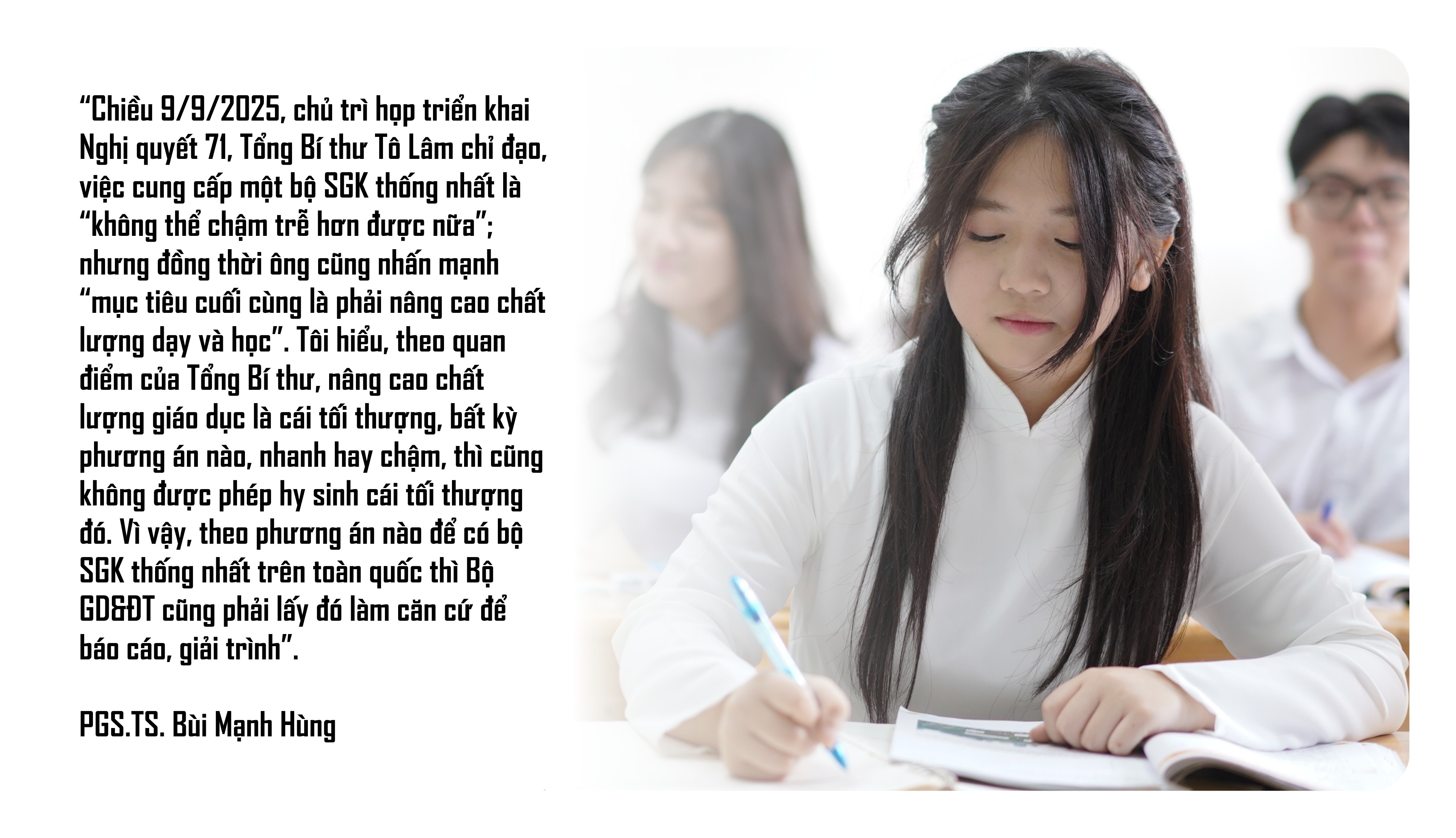
However, this option has a limitation that the unified textbook set may not ensure systematicity and consistency between subjects and between levels of education. For a "national textbook set", this is a significant limitation. Moreover, the selection of textbooks for each subject in each set must also have scientific and objective criteria as in option 2, not divided equally mechanically. And the selection process is also very difficult, and may even be more complicated than option 2 because it has to handle many subjects and many levels.
Regarding option 3, the combination can be done in two ways. The first way is that textbooks for a subject at all three levels (Primary, Middle, High School) in the new textbook set are taken from a certain current textbook set, for example, textbooks for subject A are chosen from set 1, textbooks for subject B are chosen from set 2, etc. This method has the advantage of ensuring consistency between the three levels, helping to overcome some of the limitations of the combination of three sets of books.
The second way is that textbooks for a subject at all three levels in the new textbook set can be combined from textbooks from two or three sets of books depending on the advantages of each set of books at each level (according to the criteria issued by the Ministry of Education and Training). The second way of combining has the advantage of being able to share books among sets of books, but will cause textbooks for subjects that are not selected to be separated, and if they continue to be circulated, their usability will be quite limited.
Regardless of the plan, the existing textbooks (in case they are not selected, in full sets or individual books) should continue to be circulated (not compulsory textbooks) to ensure diversity in teaching materials, an important condition for developing an "open and flexible education system", "textbooks and teaching and learning support materials suitable for each learner" as Resolution 29-NQ/TW affirmed.
The circulation of some teaching materials other than the unified textbook set also helps to mitigate the risk of the education system returning to the old curriculum and textbook model, returning to a teaching method framed in a single approach, which harms the goal of training people with creative capacity - a capacity that contributes to the training of high-quality human resources; it is especially important to emphasize that the use of open learning materials creates conditions for continued innovation in testing and assessment.
According to many people, once there is a unified set of textbooks, other sets of textbooks will find it difficult to survive for long because of unfair competition. The unfairness is obvious to everyone, but if the State really wants to develop a diverse "learning materials ecosystem" that is beneficial to the education system, it can still have appropriate policies to nurture it like the way we are protecting the diversity of species in the natural environment.
When the innovation process according to the policy expressed in the Resolutions of the Party, the National Assembly and in the spirit of the 2018 General Education Program takes a step forward, the role of textbooks will be more correctly perceived. Although using a unified set of textbooks may put the perception of textbooks at risk of returning to the old way, if the Ministry of Education and Training has close direction, especially in the work of testing and assessment (for example, continuing to regulate the use of materials outside of textbooks when making test and exam questions), the new concept of textbooks will not be deviated.
As one of many teaching materials, not having a legal nature, the unified textbook set will not have the exclusive position as before. Other learning resources, including textbooks that are not selected, still need to continue to contribute to teaching activities, especially for competent and dedicated teachers in schools with conditions.
If new textbooks are compiled, before compiling, it is necessary to urgently revise the 2018 General Education Program to suit the new context, especially when artificial intelligence has rapid developments. After revision, we will have the 2018 General Education Program version 2 and new textbooks will be compiled according to this version.
If you choose to get a new set of textbooks from the current textbooks, that set of textbooks can be edited and revised for use in the 2026-2027 school year and will also have to be fundamentally revised after the 2018 General Education Program version 2 is available. Other textbooks, if used as a type of supplementary learning materials, can be updated according to the new version of the program, or not.
Dr. Nguyen Viet Huy - Deputy Head of General Education Department, Department of Education and Training of Hung Yen province: Mobilizing all resources with the highest political determination, along with innovative and creative approaches to have a set of quality textbooks.
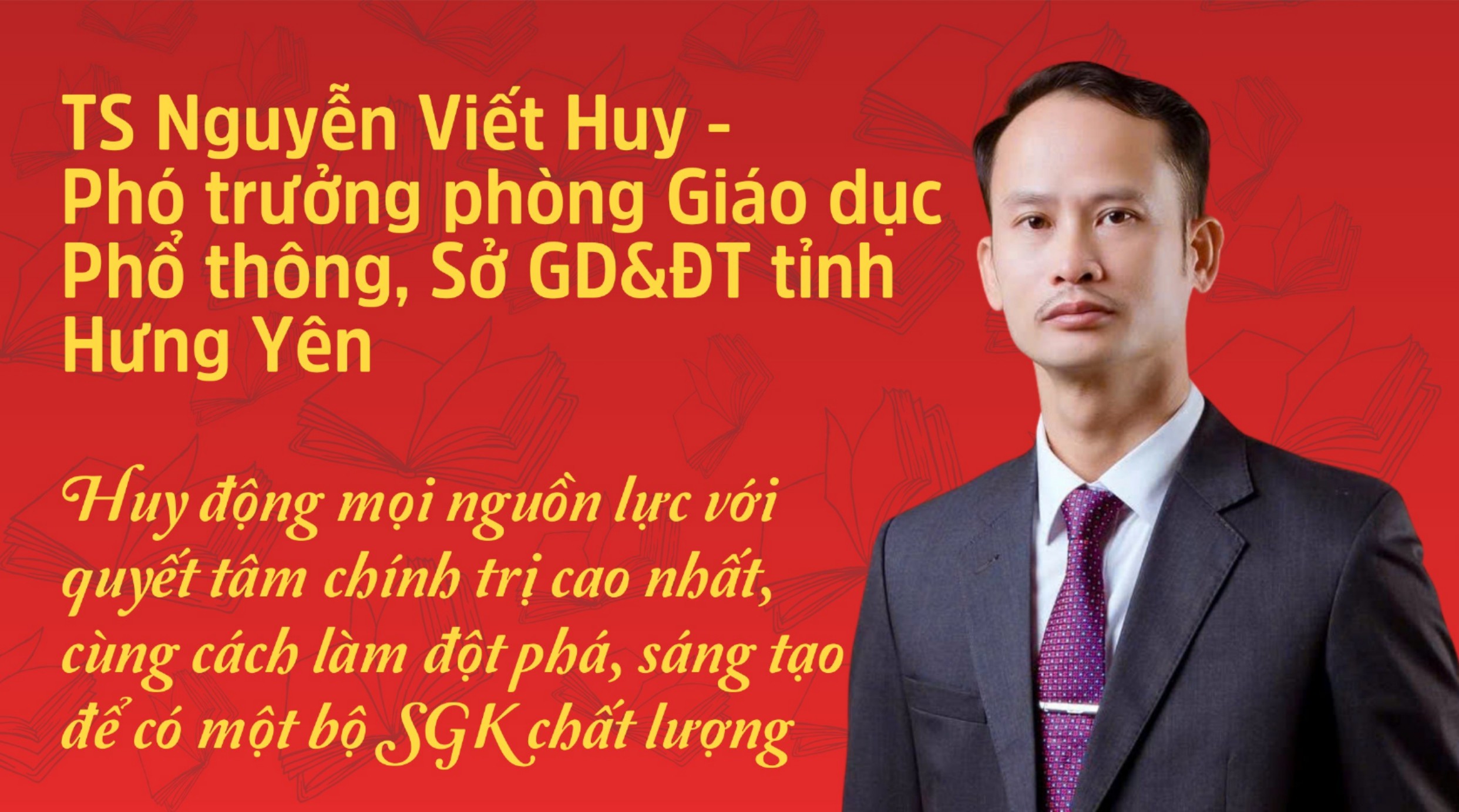
Resolution No. 88/2014/QH13 dated November 28, 2025 of the National Assembly on innovation of general education programs and textbooks clearly states: "Implement socialization of textbook compilation; have a number of textbooks for each subject".
The reality of implementing the 2018 General Education Program in recent years has shown that the policy of one program, many sets of textbooks is correct and progressive. Schools and teachers have the right to choose textbooks to serve the innovation of teaching methods. Students are allowed to use textbooks printed with good quality. Experts, scientists... participating in writing textbooks must try their best to write quality books to be selected by educational institutions; the efforts of educational management agencies in assessing, approving, and selecting textbooks...
However, the practical implementation of selecting and using textbooks also encounters a number of difficulties and challenges.
For teachers: When studying different textbooks for the same grade level, sometimes there are problems with inconsistent understanding of some materials, data, etc., causing confusion in testing, evaluating, and reviewing for final exams for students.
For professional agencies: Must consider and calculate when collecting data to build a question bank for annual survey and graduation exams to ensure fairness and objectivity when candidates study different sets of textbooks.
For parents: Sometimes they worry about whether the textbooks of their children from the previous school can be used for the next school; having to buy another set of textbooks when their children transfer to another school that does not choose that set of textbooks...

In response to practical demands, Resolution No. 281/NQ-CP dated September 15, 2025 promulgating the Government's Action Program to implement Resolution No. 71-NQ/TW clearly states: "The Ministry of Education and Training shall preside over and coordinate with relevant ministries and agencies: Review and complete the General Education Program, increase the duration of science, technology, information technology, and arts subjects; ensure the provision of a unified set of textbooks nationwide for use from the 2026-2027 school year; implement the roadmap to 2030 to provide free textbooks to all students".
I think this is an urgent task, with the direct attention and direction of Party and State leaders and the expectations of all classes of people, so it needs to be done immediately with all resources and breakthrough methods.
In my opinion, if we write a completely new set of books with a strict process from compilation, testing, appraisal, publication, training in use... then in less than 1 year we will encounter a lot of pressure and difficulties, and we cannot guarantee that it will be better than the existing textbooks.
Therefore, in order to use the resources that have been carefully built over the years, avoid waste, and meet the goal of having a set of textbooks provided nationwide, we can study some of the following proposals:
There needs to be discussion and agreement between the Ministry of Education and Training and publishers in sharing existing textbook resources to help the education sector nationwide carry out the political tasks assigned by the Party and State.
Survey and collect opinions of a number of teachers nationwide on textbooks to ensure reliability and objectivity in order to synthesize, analyze, and evaluate the advantages and limitations of the content in each textbook set of publishers. Collecting teachers' opinions is done randomly, with a large enough number, and respondents must be identified; synthesizing and analyzing results can be done quickly using artificial intelligence applications.
The results of the evaluation of the advantages and limitations of the above contents are sent to scientists, education experts, teachers, etc. to unify the editing, supplementing, perfecting and including that content in the new textbooks.
With high political determination; unity and consensus of publishers and enthusiastic comments of teachers; support of artificial intelligence (AI) applications in handling technical requirements, the goal of providing a set of textbooks for common use nationwide, in my opinion, is completely feasible.
Performed by: Hieu Nguyen - Presented by: Le Nghia.
Source: https://giaoducthoidai.vn/hien-ke-xay-dung-mot-bo-sach-giao-khoa-thong-nhat-post748971.html


![[Photo] Secret Garden will appear in Nhan Dan Newspaper's Good Morning Vietnam 2025 project](https://vphoto.vietnam.vn/thumb/1200x675/vietnam/resource/IMAGE/2025/9/19/cec307f0cfdd4836b1b36954efe35a79)

![[Photo] Prime Minister Pham Minh Chinh chairs the sixth meeting of the Red River Delta Coordination Council](https://vphoto.vietnam.vn/thumb/1200x675/vietnam/resource/IMAGE/2025/9/20/310e73a867174433b2c489ec309c9063)

![[Photo] Spreading Vietnamese culture to Russian children](https://vphoto.vietnam.vn/thumb/1200x675/vietnam/resource/IMAGE/2025/9/19/0c3a3a23fc544b9c9b67f4e243f1e165)




























![[Photo] Sea turtle midwives](https://vphoto.vietnam.vn/thumb/1200x675/vietnam/resource/IMAGE/2025/9/19/9547200fdcea40bca323e59652c1d07e)

































































Comment (0)